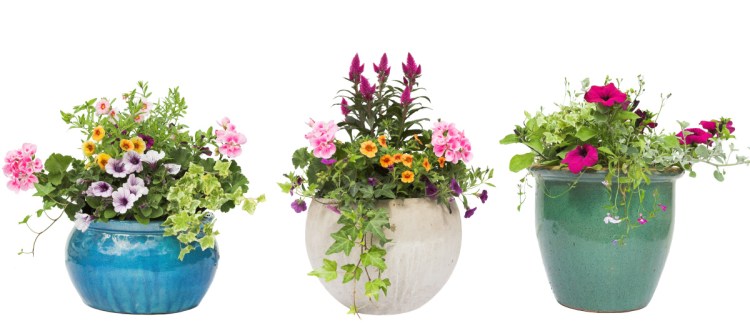Planting and replanting pots is the easiest way to celebrate the changing seasons of the gardening year. The containers can be placed on a porch or steps, along a walkway or in some other highly visible spot, making people smile whenever they walk by.
Traditionally, the container-gardening season begins on Memorial Day weekend. People plant geraniums and similar tender annuals that will bloom through the summer and that they can then forget about until the frost kills them in the fall. But following that practice, gardeners will lack any eye-brighteners from now until Memorial Day – which makes for a dull couple of months – and from first frost until the arrival of snow, as well.
How to fix that? The simplest answer for the early containers is pansies. I wrote about those spring beauties a few weeks ago, and I am not going to repeat myself. But I will add one bit of advice: Don’t be skimpy. Buy a few flats of these violas with different colored blossoms, pack them in and enjoy them until either you replace them with summer-flowering annuals or they wilt in the (to be hoped for) June heat.
Tulips or other spring-flowering bulbs are other common plants for planters. The city of Portland plants its street containers with tulips every year, and they are gorgeous. If you want such beauty this year, you will have to buy pre-potted, pre-chilled containers from your local nursery. Next year (and put this on your calendar for September) buy some bulbs – maybe from a nonprofit group that is selling them for a fundraiser – and pot them in any plastic nursery pots you’ve got hanging around, then leave them in an unheated garage or protected from predators outdoors for six to eight weeks of cold. You can bring them inside (one or two pots at a time – to extend your bloom time), water them thoroughly and put them in an attractive container. You’ll get 4 to 6 weeks of bloom inside before any blooms start outside.
Use those you didn’t bring inside to force blossoming early for your early-spring pots outside. That is what my wife Nancy and I will be doing with the ones that were so frozen under mulch, chicken wire and refrozen melted snow that we couldn’t get them inside this year to enjoy the winter blossoms. Daffodils, tulips and hyacinths mix well in the pot and will add a bit of attractive height next to the low-growing pansies. Lettuce or foliage plants like ivy add texture. Be creative.
After Memorial Day provides the widest leeway for containers. Pull all of the plants from the spring display and start over, or just use a serrated knife to slice through the roots of the plants you want to remove, filling the holes with fresh potting soil.
If you like traditional, go with geraniums, New Guinea impatiens, snapdragons and petunias. Or you could add tropicals, such as cannas and bananas. The world is open to you.
In the summer, most designs adhere to a gardening principle known as “thriller, filler and spiller.”
The thriller is the tall centerpiece: grasses or tropicals like banana and canna. Plants that blossom constantly, like dahlias, or any with striking foliage with coleus or heucheras, also qualify as thrillers.
The fillers weave in and around the thrillers. In addition the geraniums, impatiens, snapdragons and petunias mentioned above, begonias and calibrachoa will blossom nonstop.
Spillers are the plants that drape toward the ground outside the container. This is where ivy comes in. You also can use nasturtiums, sweet potato vine, morning glories and more.
Come fall, deep oranges and purples look right at home in any containers. Chrysanthemums are the standard fall flower, but flowering cabbage and kale also look nice. Fall is harvest time, so Bright Lights Swiss chard – both attractive and edible – makes a good addition to a container.
That would end the season for growing plants in your containers. But it needn’t be the end of the containers.
Cut some holly – either the native winterberry or the English holly – some needled evergreens and perhaps some birch twigs; add them to your container, and you can enjoy it all winter.
TOM ATWELL is a freelance writer gardening in Cape Elizabeth. He can be contacted at: tomatwell@me.com.
Send questions/comments to the editors.



Comments are no longer available on this story